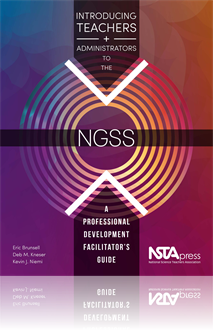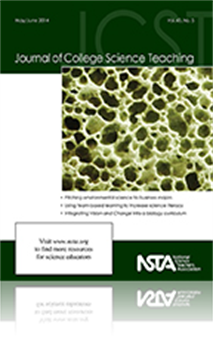All Resources
Book Chapter
The purpose of this lab is for students to apply their understanding of transpiration in plants to determine ”How Does Leaf Surface Area Affect the Movement of Water Through a Plant?” The lab also gives students an opportunity to design and carry...
Book Chapter
The purpose of this lab is for students to apply what they know about the function of enzymes to determine ”How Do Changes in Temperature and pH Levels Affect Enzyme Activity?” The lab also gives students an opportunity to design and carry out a ...
Book Chapter
The purpose of this lab is to introduce students to how population size changes over time and to determine ”How Do Changes in the Amount and Nature of the Plant Life Available in an Ecosystem Influence Herbivore Population Growth Over Time?” The ...
Book Chapter
Predator-Prey Population Size Relationships
The purpose of this lab is to introduce students to the concept of a predator-prey population size relationship and to determine ”Which Factors Affect the Stability of a Predator-Prey Population Size Relationship?” The lab also gives students an ...
Book Chapter
The purpose of this lab is to introduce students to the concepts of ecosystems, food chains, food webs, and biodiversity, and to determine ”How Does Food Web Complexity Affect the Biodiversity of an Ecosystem?” The lab also gives students an oppo...
Book Chapter
Environmental Influences on Animal Behavior
The purpose of this lab is for students to apply what they know about animal behavior and the interactions among species and their environment to determine ”How Has Climate Change Affected Bird Migration?” The lab also gives students an opportuni...
Book Chapter
The purpose of this lab is for students to apply what they know about food webs, nutrient cycling, and the interdependence of organisms within an ecosystem to develop an explanation for “Why Is the Sport Fish Population of Lake Grace Decreasing in ...
Book Chapter
The purpose of this lab is for students to apply what they know about ecological communities, population growth, and the interdependence of organisms within an ecosystem to determine “How Has the Spread of the Eurasian Collared-Dove Affected Diffe...
Book Chapter
The purpose of this lab is to introduce students to the underlying mechanisms that influence how traits are inherited and to determine ”Why Are the Stem and Leaf Color Traits of the Wisconsin Fast Plant Inherited in a Predictable Pattern?” The la...
Book Chapter
The purpose of this lab is to introduce students to the chromosomal basis of inheritance and the nature of chromosomal genetic disorders to determine ”How Do Two Physically Healthy Parents Produce a Child With Down Syndrome and a Second Child With ...
Book Chapter
The purpose of this lab is to introduce the concept of deoxyribonucleic acid (DNA) and to define ”What Is the Structure of DNA?” The lab explains how genetic information is stored, transferred, and conserved and also gives students an opportunit...
Book Chapter
The purpose of this lab is to introduce students to the process of meiosis at the chromosomal level to determine ”How Does the Process of Meiosis Reduce the Number of Chromosomes in Reproductive Cells?” It also gives students an opportunity to d...
Book Chapter
The purpose of this lab is to give students an opportunity to apply what they know about the inheritance of traits to solve a problem ”Are All of Mr. Johnson’s Children His Biological Offspring?” This lab also gives students an opportunity to ...
Book Chapter
The purpose of this lab is to give students an opportunity to apply what they know about the inheritance of traits to determine “Which Model of Inheritance Best Explains How a Specific Trait Is Inherited in Fruit Flies?” This lab also gives stu...
Book Chapter
Biodiversity and the Fossil Record
The purpose of this lab is to introduce students to the history of life on Earth and to help them discover “How Has Biodiversity on Earth Changed Over Time?” This lab also gives students an opportunity to use an existing data set and mathematics...
Book Chapter
The purpose of this lab is to introduce students to the effects of predation and explain “Why Will the Characteristics of a Bug Population Change in Different Ways in Response to Different Types of Predation?” Students will also have an opportun...
Book Chapter
The purpose of this lab is for students to apply what they have learned about the theory of descent with modification to explain “Does Mammalian Brain Structure Support or Refute the Theory of Descent with Modification?“ This lab also gives stud...
Book Chapter
The purpose of this lab is to have students apply what they know about natural selection to explain the process of allopatric speciation and to discover “Why Does Geographic Isolation Lead to the Formation of a New Species?” It also gives stude...
Book Chapter
The purpose of this lab is for students to apply their understanding of evolutionary relationships or phylogeny to determine ”How Are Humans Related to Other Members of the Family Hominidae?” It also provides students with an opportunity to anal...
Book Chapter
The purpose of this lab is for students to apply their understanding of protein synthesis, descent with modification, and cladograms to identify “How Are Whales Related to Other Mammals?” They will also have an opportunity to access and use an...
NSTA Press Book
Introducing Teachers and Administrators to the NGSS: A Professional Development Facilitator's Guide
REVERE Award Finalist, PreK-12 Learning Group, Association of American Publishers!If you’re charged with helping educators achieve the vision of the new science standards, this is the professional development resource you need. This book is chock-f...
By Eric Brunsell, Deb M. Kneser, Kevin J. Niemi
eBook
If you’re charged with helping educators achieve the vision of the new science standards, this is the professional development resource you need. This book is chock-full of activities and useful advice for guiding teachers and administrators as the...
Journal Article
Getting More Scientists to Revamp Teaching
The rapid diffusion of clickers at their university leads the authors to propose that faculty development strategies may gain in being explicitly informed by both the scientists' most immediate needs as teachers and the findings from diffusion of inn...
Journal Article
Pitching Environmental Science to Business Majors: Engaging Students in Renewable Energy Choices
This article describes an active learning strategy for engaging undergraduate business students, a group often ignored in scientific pedagogy, in learning about renewable energy technology and associated trade-offs...
Journal Article
Integrating Vision and Change Into a Biology Curriculum at a Small Comprehensive College
The authors describe the process of curricular change that occurred in the Biology Department of Elmhurst College in the suburbs of Chicago. This 10-year process involved an update of the mission statement, revision of the lower level core course seq...
Journal Article
Examples From the Trenches: Improving Student Learning in the Sciences Using Team-Based Learning
One method for reforming how college science is taught is shifting to a more student-centered collaborative instructional format using team-based learning (TBL). The purpose of this article is to describe the structure and implementation of TBL and t...
Journal Article
Undergraduate Research and a Liberal Arts Education: Similar Goals, Similar Solutions
In this article the authors argue that the goals of a liberal arts education and undergraduate research are remarkably similar and that by incorporating an undergraduate research focus with a liberal arts approach in the classroom, instructors can mo...
Journal Article
There are few instruments available that science educators can use to assess whether students can apply what they know about scientific practices to critique scientific media reports. In response to the need for valid, reliable, and informative asses...
Journal Article
Although student production of arguments in group learning environments has been shown to promote scientific reasoning and understanding of science concepts, little previous work has examined the relationship of the structure of curricular materials ...
Journal Article
The study described in this article aimed to quantify knowledge and misconceptions of evolutionary processes among upper level undergraduate students and analyze how knowledge and misconceptions changed throughout a semester-long, discussion-based co...
Journal Article
This study explores the use of Photovoice as a pedagogical tool in two introductory undergraduate chemistry courses for nonscience majors....
Journal Article
Point of View: The Need for Fieldwork in Science
The author makes a case for fieldwork as having a strong capacity for increasing both science and nonscience majors' abilities to learn complex concepts, with the added benefit of actively engaging minority and female students in science....
Journal Article
This study evaluates the effectiveness of human anatomy software in face-to-face and online anatomy laboratory classes....
Journal Article
Case Study: The Mystery of the Seven Deaths: A Case Study in Cellular Respiration
In this interrupted, problem-based case study, students explore the purpose of cellular respiration as they play the role of medical examiner, analyzing autopsy evidence to determine the mysterious cause of death for seven people....
Book Chapter
The activities in this chapter provide an introduction to the NGSS. Activity 1 allows educators to explore the progressions of NGSS to begin understanding the structure of NGSS....
Book Chapter
Facilitating Professional Development Using This Book
This chapter discusses how to use the book to plan professional development. It includes a description of two “strands” of work that schools need to engage in during the implementation process, provides guideposts for effective professional devel...
Book Chapter
This chapter identifies a series of challenging questions and issues that arise frequently during professional development related to the Next Generation Science Standards (NGSS). Through discussions, reflections, and workshop evaluations, we identif...
Book Chapter
This chapter provides suggestions for administrators as they consider how to lead and support implementation of the Next Generation Science Standards (NGSS). It’s important to remember that change happens in a very thoughtful, planned way. Implemen...





